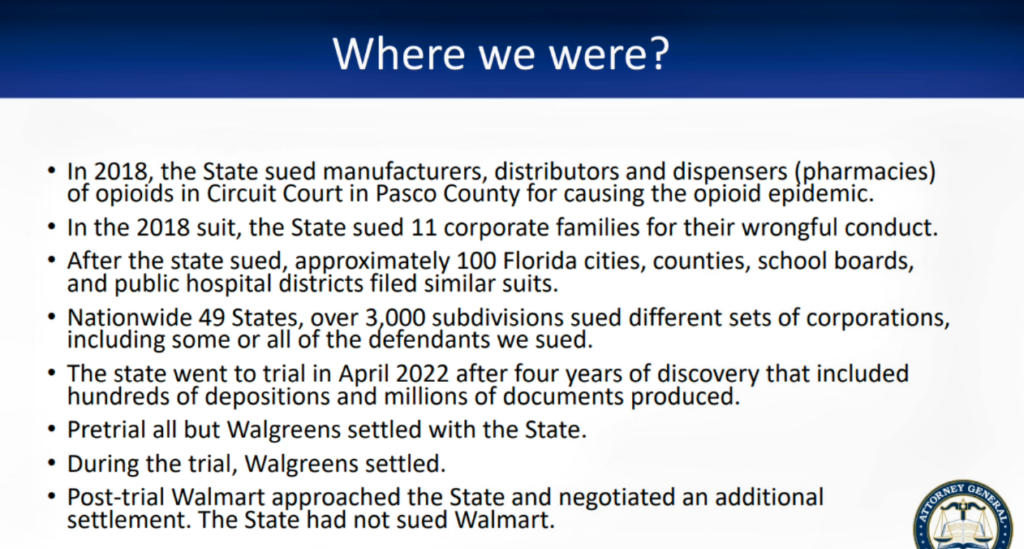Thrive
Pinellas to receive $110 million from opioid lawsuits

After over four years of litigation and negotiations, Pinellas County officials and their municipal partners will receive around $110 million from conglomerates deemed responsible for the opioid epidemic.
While payments spread over 18 years, state leadership recently received its first installment of $205.7 million for opioid abuse prevention and treatment programs. Documents show Florida’s settlement totals $3.2 billion.
The state will also receive $84 million worth of Naloxone, used to treat opioid overdoses and now offered free through the Department of Health-Pinellas (DOH-P), over the next 10 years.
“I certainly hope that it sends a message, not only to the pharmaceutical companies but others,” said Lourdes Benedict, assistant county administrator. “I know this money will make a difference.”
The Florida Senate Appropriations Committee on Health and Human Services, which includes St. Petersburg Sen. Darryl Rouson, heard an update on the opioid settlements during Wednesday’s meeting. According to Chief Deputy Attorney General John Guard’s presentation documents, “this was – and is – one of the most complicated sets of settlement negotiations ever accomplished.”
In 2018, the state sued 11 manufacturers, distributors and pharmacies in a Pasco County Circuit Court. About 100 counties, cities, school boards and public hospitals (subdivisions) then filed similar litigation.
“In order to settle matters, we had to not only settle the state’s claims but resolve all political subdivision claims,” read Guard’s presentation. “Because of this, the state negotiated an allocation agreement with Florida’s counties and cities on how the settlement monies would be divided.
“With limited exception, all the funds can only be used to abate or remedy the opioid epidemic.”

A graphic showing litigation background information. Screengrab.
The settlements come from opioid pharmaceutical companies and retail behemoths like CVS, Walgreen and Walmart. Pinellas County and its municipal partners, which include the City of St. Petersburg, received $13.45 million of the initial allotment.
The bulk of the local allocation, $90.6 million, comes from what state officials classify as a regional fund. In addition, Lourdes Benedict, assistant county administrator, said Pinellas would receive about $20 million through county-specific money.
Representatives from Pinellas and its cities formed an Opioid Abatement Board and recently signed an interlocal agreement to disperse the settlement. Benedict explained they work closely with the county-wide Opioid Task Force to identify the most pressing community needs.
The Abatement Board includes Clearwater City Councilmember Kathleen Beckman; St. Petersburg Fire Rescue Chief Ian Womack; Pinellas Park Mayor Sandra Bradbury; County Commissioner Kathleen Peters; and Dr. Ulyee Choe, director of the DOH-P. Choe also oversees the Task Force.
While the Abatement Board is just getting underway, Bendict relayed that they plan to use some of the county settlement to support hospitals treating residents with opioid use disorder (OUD).
“To get them (patients) services, provide medications they may need and help educate hospitals on how to work with individuals that are coming in,” Benedict added. “We already have a pilot with Bayfront Health (St. Petersburg) that’s going very well. So, our goal and our hope is to expand that.”
She said the pilot program is already successful in its first few months. Buffalo, New York’s initiative served as a model, and Benedict said, “it made a huge difference in opioid deaths.”
She explained that the program provides peer specialists who help sign overdose patients up for several wraparound services, and they also provide pertinent medications. Most importantly, patients receive both before walking out hospital doors.
Pinellas could use the help, as Benedict noted over 600 people died from opioid overdoses in the county last year. She said health officials project that another 619 will die in 2023.
“Every year, it’s gone higher,” Benedict lamented. “So, I know this money will make a difference here.”

A graphic showing where the money is coming from. Screengrab.
According to the documents, state, county and city officials compiled a 13-page list of programs eligible for settlement funding. Most encompass prevention, treatment, recovery and interdiction efforts related to opioids, substance abuse and poly-drug use.
The money can also cover mental health treatments. It can “likely” go towards jail and pretrial drug treatment programs, anti-drug coalitions and youth prevention, related law enforcement training, drug courts and disposal efforts.
By April, 100 state Walmart pharmacies will stock Naloxone. Qualified law enforcement agencies and first responders can then show ID and obtain up to five two-packs for official use.
Rouson, speaking at a Feb. 17 St. Petersburg Area Chamber of Commerce meeting, said the governor recommended spending $334 million on substance abuse and mental health programs this year. Some of that will come from the state’s opioid settlement, and Rouson said he “intends to be quite involved in that process.”
Regardless of how much money local governments receive, Benedict rhetorically asked, “what price can you put on a life?”
“Is it enough?” Benedict added. “No, it’s not.”
Read the full settlement presentation here.







